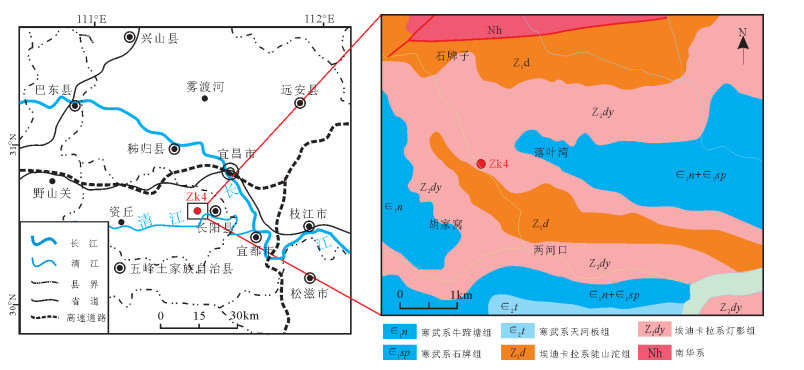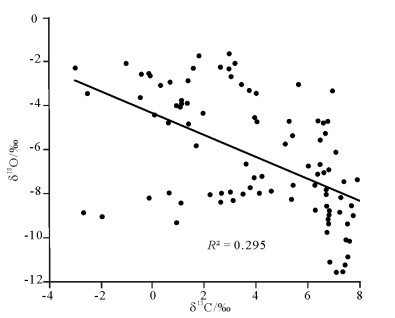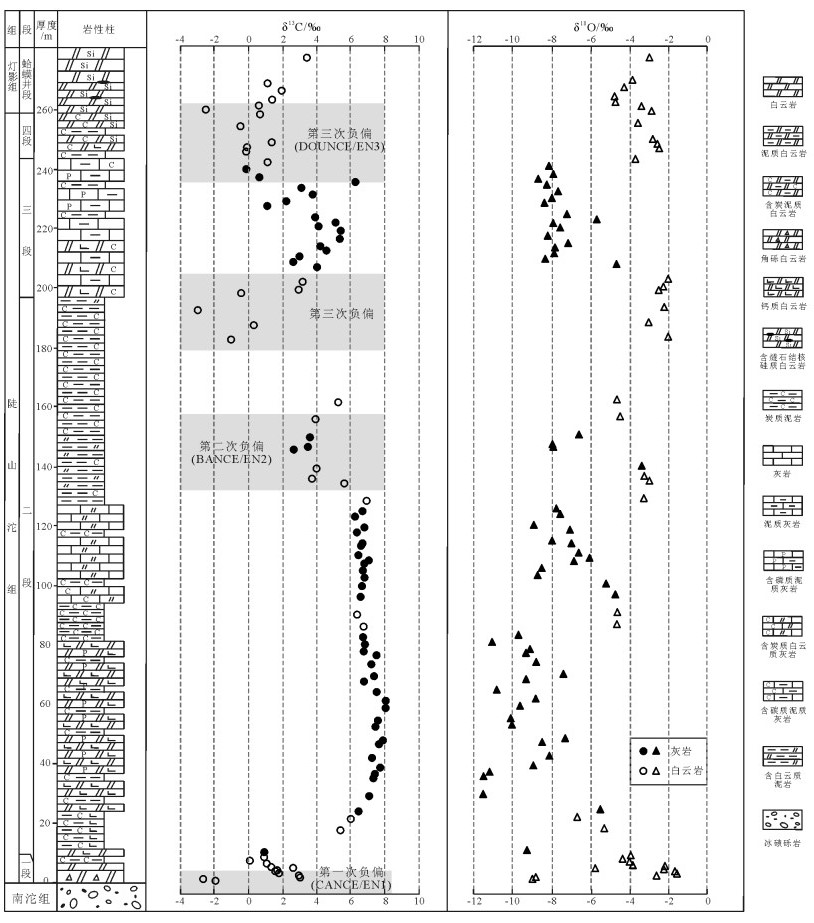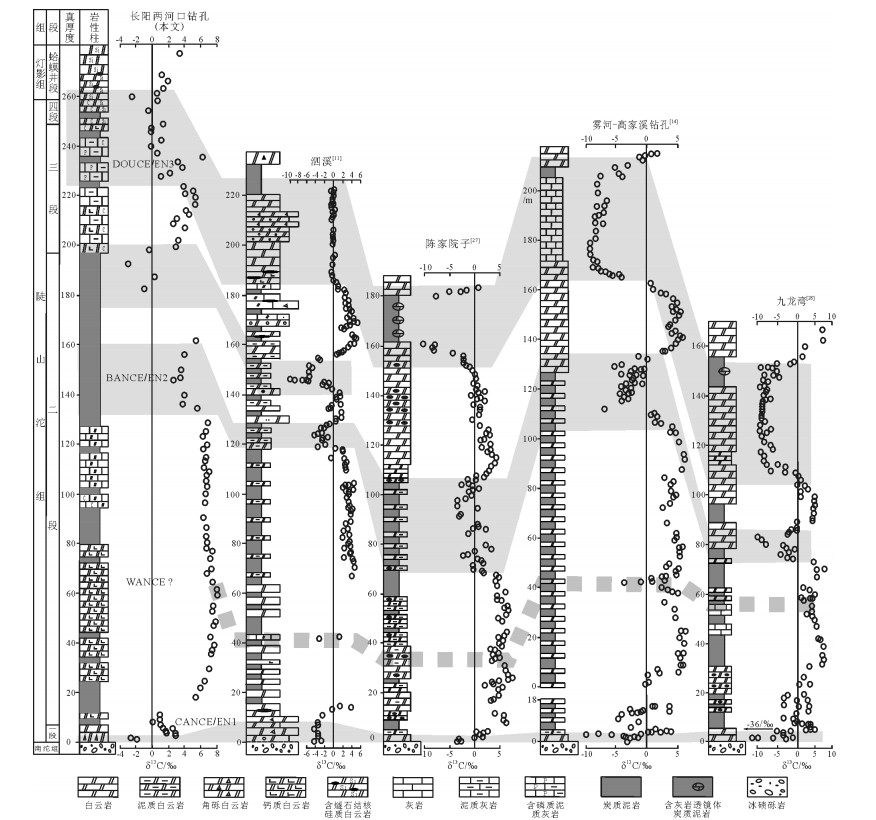Carbon isotopic composition of the Ediacaran Doushantuo Formation from ZK04 drill hole in Changyang of west Hubei Province and its significance for stratigraphic correlation
-
摘要:
对湖北长阳两河口ZK04钻孔岩心进行了详细的碳酸盐岩C、O同位素分析,识别了埃迪卡拉系陡山沱组4次明显的δ13C负偏离,分别位于陡山沱组一段、二段中上部、二段上部和三段上部至四段。其中第1、2和4次δ13C负偏离与黄陵背斜周缘的剖面能够很好地对应,具有重要的区域和全球地层对比意义。在第1次δ13C正偏离区域内并未发现明显的δ13C负偏,分析认为WANCE事件可能仅代表了峡东部分地区一次短暂的δ13C降低事件。第3次δ13C负偏离表现最显著,然而在秭归泗溪和青林口以外的其他地区未见报道,可能是由于水体较浅的区域发生了地层缺失,未能保存此次δ13C负偏离。长阳ZK04孔陡山沱组顶部的第4次δ13C负偏离表现较弱,考虑到陡山沱组四段的黑色页岩较少发育,推测长阳两河口地区在陡山沱晚期处于浅水台地或台地边缘。DOUNCE可能是地史时期最大的一次全球性C同位素负偏离事件,其与大型具刺疑源类化石群和埃迪卡拉生物群的发展演化有紧密的联系,对于全球埃迪卡拉纪统级地层对比具有重要的意义。
Abstract:The authors analyzed carbon and oxygen isotopes of Ediacaran Doushantuo Formation from ZK04 drilling core, Lianghek-ou of Changyang, Hubei Province.The carbon isotope trends show 4 negative excursions which exist in Member 1, the medium-up-per part of Member 2, the upper part of Member 2 and the Upper Member 3 to Member 4 of Doushantuo Formation, respectively.The first, second and the fouth negative δ13C excursions can be well correlated to those from other sections of the Yangtze Gorges, and are of great significance for the regional and global Ediacaran stratigraphic correlation.Since the notable negative excursion in the first positive δ13C excursion is not observed in the ZK04 drilling core, the authors hold that the WANCE event could merely repre-sent a short-term δ13C decrease in partial area of Yangtze Gorges.The third, which was the strongest negative δ13C excursion, has not been reported in other regions, except for Sixi and Qinglinkou of Zigui County.A probable explanation is that there occurred stratigraphic gap in the relatively shallow water.The relatively weak negative δ13C excursion at the top of Doushantuo Formation, as-sociated with the less developed black shales, suggests that the Lianghekou area of Changyang might have been located at the shallowwater platform or platform margin during the late Doushantuo period.DOUNCE was probably the most negative event of δ13C in the geological time, and it is believed to have been closely linked to the evolution of the large acanthomorphic acritarchs and the Edia-caran biota, accordingly it may be of great importance for global Eidacaran stratigraphic subdivision.
-
Keywords:
- Doushantuo Formation /
- carbon-oxygen isotope /
- drilling core /
- Changyang
-
致谢: 审稿专家和中国地质调查局武汉地质调查中心陈孝红研究员对论文提出了宝贵的修改意见,武汉地质调查中心同位素地球化学实验室于桂香老师和蔡应雄工程师帮助完成了C、O同位素分析,在此一并致以诚挚的谢意。
-
表 1 湖北长阳ZK04钻孔C、O稳定同位素和Mn/Sr值测试结果
Table 1 Stable carbon and oxygen isotopic data and Mn/Sr ratios of the ZK04 drilling core in Changyang, Hubei Province
序号 样品号 深度/m 岩性 δ13CPDB/‰ δ18OPDB/‰ Mn/Sr 1 ZK04-1T 9.5 白云岩 3.42 -3.03 2 ZK04-2T 18.3 白云岩 1.11 -3.90 3 ZK04-3T 20.8 白云岩 1.94 -4.33 4 ZK04-3-2T 23.9 白云岩 1.41 -4.82 5 ZK04-3-2T* 白云岩 1.38 -4.82 6 ZK04-4T 25.9 白云岩 0.60 -4.77 7 ZK04-5T 27.3 白云岩 -2.52 -3.44 8 ZK04-6T 28.9 白云岩 0.67 -2.92 9 ZK04-8T 33.0 白云岩 -0.45 -3.62 10 ZK04-8T* 白云岩 -0.48 -3.62 11 ZK04-10T 38.5 白云岩 1.36 -2.86 12 ZK04-11T 40.2 白云岩 -0.10 -2.63 13 ZK04-12T 41.7 白云岩 -0.15 -2.53 0.30 14 ZK04-13T 45.3 白云岩 1.10 -3.66 15 ZK04-13T* 白云岩 1.11 -3.75 16 ZK04-14T 47.7 灰岩 -0.14 -8.18 0.76 17 ZK04-15T 50.5 灰岩 0.62 -7.97 18 ZK04-15T* 灰岩 0.63 -7.95 19 ZK04-16T 52.1 灰岩 6.27 -8.73 20 ZK04-17T 54.1 灰岩 3.10 -8.29 21 ZK04-18T 56.4 灰岩 3.76 -7.71 22 ZK04-19T 58.7 灰岩 2.20 -8.16 0.34 23 ZK04-19T* 灰岩 2.21 -8.03 24 ZK04-20T 60.3 灰岩 1.09 -8.41 25 ZK04-21T 64.2 灰岩 3.91 -7.26 26 ZK04-22T 66.0 灰岩 5.12 -5.74 27 ZK04-22T* 灰岩 5.11 -5.73 28 ZK04-23T 67.3 灰岩 4.11 -7.96 29 ZK04-24T 68.8 灰岩 5.41 -7.60 30 ZK04-25T 71.6 灰岩 5.35 -8.24 0.43 31 ZK04-26T 74.1 灰岩 4.23 -7.08 32 ZK04-26T* 灰岩 4.21 -7.20 33 ZK04-27T 75.6 灰岩 4.57 -7.87 34 ZK04-28T 77.6 灰岩 2.99 -7.91 35 ZK04-29T 79.5 灰岩 2.61 -8.43 36 ZK04-29T* 灰岩 2.62 -8.37 37 ZK04-30T 81.3 灰岩 4.02 -4.72 38 ZK04-31T 86.3 白云岩 3.17 -2.07 0.64 39 ZK04-32T 89.0 白云岩 2.94 -2.32 40 ZK04-33T 90.2 白云岩 -0.44 -2.56 41 ZK04-34T 96.0 白云岩 -3.00 -2.32 42 ZK04-34T* 白云岩 -2.99 -2.28 43 ZK04-35T 101.2 白云岩 0.30 -3.07 44 ZK04-36T 106.1 白云岩 -1.03 -2.07 45 ZK04-37T 127.6 白云岩 5.26 -4.70 46 ZK04-38T 133.4 白云岩 3.93 -4.51 47 ZK04-38T* 白云岩 3.93 -4.53 48 ZK04-39T 139.6 灰岩 3.60 -6.64 0.30 49 ZK04-40T 142.9 灰岩 3.48 -8.00 50 ZK04-41T 143.8 灰岩 2.59 -8.00 51 ZK04-41T* 灰岩 2.65 -7.96 52 ZK04-42T 150.3 白云岩 3.99 -3.43 53 ZK04-43T 153.8 白云岩 3.72 -3.30 54 ZK04-44T 155.4 白云岩 5.62 -3.03 0.31 55 ZK04-45T 161.4 白云岩 6.93 -3.26 56 ZK04-45T* 白云岩 6.93 -3.32 57 ZK04-46T 164.9 灰岩 6.69 -7.80 58 ZK04-47T 166.8 灰岩 6.25 -7.60 59 ZK04-48T 170.5 灰岩 6.74 -9.05 60 ZK04-48T* 灰岩 6.80 -8.95 61 ZK04-49T 172.2 灰岩 6.36 -7.10 0.56 62 ZK04-50T 175.9 灰岩 6.69 -8.02 63 ZK04-51T 176.8 灰岩 6.60 -7.03 64 ZK04-52T 180.0 灰岩 6.47 -6.78 65 ZK04-52T* 灰岩 6.45 -6.66 66 ZK04-53T 181.8 灰岩 7.06 -6.10 67 ZK04-54T 182.9 灰岩 6.79 -6.90 68 ZK04-55T 185.3 灰岩 6.71 -8.55 0.35 69 ZK04-56T 187.7 灰岩 6.81 -8.76 70 ZK04-57T 190.6 灰岩 6.66 -5.25 71 ZK04-58T 194.3 灰岩 6.58 -4.78 72 ZK04-59T 200.4 白云岩 6.37 -4.68 73 ZK04-60T 204.5 白云岩 6.75 -4.70 74 ZK04-61T 208.1 灰岩 6.72 -9.74 75 ZK04-62T 210.6 灰岩 6.80 -11.12 76 ZK04-62T* 灰岩 6.83 -11.09 77 ZK04-63T 213.0 灰岩 6.76 -9.15 78 ZK04-64T 214.3 灰岩 7.51 -9.36 0.24 79 ZK04-65T 217.4 灰岩 7.21 -8.83 80 ZK04-66T 221.5 灰岩 7.37 -7.44 81 ZK04-67T 223.3 灰岩 6.78 -9.35 82 ZK04-68T 226.9 灰岩 7.52 -10.85 83 ZK04-69T 229.9 灰岩 8.06 -8.86 84 ZK04-70T 232.4 灰岩 8.03 -9.69 85 ZK04-70T* 灰岩 8.05 -9.66 86 ZK04-71T 236.7 灰岩 7.59 -10.14 87 ZK04-72T 238.8 灰岩 7.45 -10.08 0.29 88 ZK04-73T 243.5 灰岩 7.89 -7.35 89 ZK04-74T 244.8 灰岩 7.66 -8.53 90 ZK04-75T 249.5 灰岩 7.25 -8.16 91 ZK04-76T 252.8 灰岩 7.73 -8.98 92 ZK04-77T 255.0 灰岩 7.42 -11.22 93 ZK04-78T 256.5 灰岩 7.31 -11.55 0.16 94 ZK04-78T* 灰岩 7.33 -11.53 95 ZK04-79T 262.6 灰岩 7.08 -11.55 96 ZK04-80T 267.8 灰岩 6.46 -5.55 97 ZK04-81T 270.4 白云岩 6.00 -6.73 98 ZK04-82T 274.3 白云岩 5.40 -5.27 99 ZK04-82T* 白云岩 5.39 -5.35 0.38 100 ZK04-83T 281.8 灰岩 0.92 -9.30 101 ZK04-84T 283.5 白云岩 0.91 -3.99 1.64 102 ZK04-85T 284.7 白云岩 0.07 -4.41 103 ZK04-86T 285.7 白云岩 1.06 -4.05 104 ZK04-87T 286.9 白云岩 1.29 -3.92 105 ZK04-87T* 白云岩 1.33 -3.88 106 ZK04-88T 287.2 白云岩 2.61 -2.24 2.78 107 ZK04-89T 288.0 白云岩 1.67 -5.81 108 ZK04-89T* 白云岩 1.68 -5.81 109 ZK04-90T 288.3 白云岩 1.56 -2.29 110 ZK04-91T 289.0 白云岩 1.78 -1.73 111 ZK04-92T 289.8 白云岩 2.95 -1.63 112 ZK04-93T 290.5 白云岩 3.02 -2.67 113 ZK04-94T 291.0 白云岩 -2.67 -8.85 114 ZK04-95T 291.6 白云岩 -1.95 -9.03 注:*为重复测试样 -
Zhu M Y, Zhang J M, Yang A H. Integrated Ediacaran (Sinian) chronostratigraphy of South China[J]. Palaeogeography, Palaeoclima-tology, Palaeoecology, 2007, 254:7-61. doi: 10.1016/j.palaeo.2007.03.025
Condon D, Zhu M Y, Bowring S, et al. U-Pb ages from the Neo-proterozoicDoushantuo Formation, China[J]. Science, 2005, 308:95-98. doi: 10.1126/science.1107765
Willman S, Moczydłowska M. Ediacaranacritarch biota from the Giles-1 drillhole, Officer Basin, Australia, and its potential forbio-stratigraphiccorrelation[J]. Precambrian Research, 2008, 162:498-530. doi: 10.1016/j.precamres.2007.10.010
Kaufman A J, Knoll A H. Neoproterozoic variations in the C-isoto-pic composition of seawater:Stratigraphic and biogeochemical impli-cations[J]. Precambrian Research, 1995, 73:27-49. doi: 10.1016/0301-9268(94)00070-8
Knoll A H. Learning to tell Neoproterozoictime[J]. Precambrian Re-search, 2000, 100:3-20. doi: 10.1016/S0301-9268(99)00067-4
Zhu M Y, Lu M, Zhang J M, et al. Carbon isotope chemostratigra-phy and sedimentary facies evolution of the EdiacaranDoushantuo Formation in western Hubei, South China[J]. Precambrian Re-search, 2003, 225:7-28. http://www.academia.edu/17380682/Carbon_isotope_chemostratigraphy_and_sedimentary_facies_evolution_of_the_Ediacaran_Doushantuo_Formation_in_western_Hubei_South_China
Jiang G Q, Shi X Y, Zhang S H, et al. Stratigraphy and paleogeogra-phy of the EdiacaranDoushantuo Formation (ca. 635-551Ma) in South China[J]. Gondwana Research, 2011, 19:831-849. doi: 10.1016/j.gr.2011.01.006
刘鹏举, 尹崇玉, 陈寿铭, 等.华南埃迪卡拉纪陡山沱期管状微体化石分布、生物属性及其地层学意义[J].古生物学报, 2010, 49(3):308-324. http://www.cnki.com.cn/Article/CJFDTOTAL-GSWX201003002.htm Zhu M Y, Lu M, Zhang J M, et al. Carbon isotope chemostratigra-phy and sedimentary facies evolution of the EdiacaranDoushantuo Formation in western Hubei, South China[J]. Precambrian Re-search, 2013, 225:7-28. doi: 10.1016/j.precamres.2011.07.019
陈寿铭, 尹崇玉, 刘鹏举, 等.湖北峡东地区牛坪剖面埃迪卡拉系C同位素组成及地质意义[J].世界地质, 2013, 32(4):641-651. http://www.cnki.com.cn/Article/CJFDTOTAL-SJDZ201304001.htm 陈孝红, 周鹏, 张保民, 等.峡东埃迪卡拉系陡山沱组稳定C同位素记录及其年代地层意义[J].中国地质, 2015, 42(1):207-223. http://www.cnki.com.cn/Article/CJFDTOTAL-DIZI201501016.htm 刘宝珺, 许效松, 潘杏南, 等.中国南方古大陆沉积地壳演化与成矿[M].北京:科学出版社, 1993:120-127. 张汉金, 胡正祥, 颜代蓉, 等.鄂西陡山沱村期岩相古地理与含磷岩系沉积规律[J].地层学杂志, 2013, 37(4):521-526. http://www.cnki.com.cn/Article/CJFDTOTAL-DCXZ201304015.htm Sawaki Y, Ohno T, Tahata M, et al. The Ediacaran radiogenic Sr isotope excursion in the Doushantuo Formation in the Three Gorg-es area, South China[J]. Precambrian Research, 2010, 176:46-64. doi: 10.1016/j.precamres.2009.10.006
Derry L A, Brasier M D, Corfield R M, et al. Sr and C isotopes in Lower Cambrian carbonates from the Siberian craton:A paleoenvi-ronmental record during the'Cambrian explosion'[J]. Earth and Planetary Science Letters, 1994, 128:671-681. doi: 10.1016/0012-821X(94)90178-3
Kaufman A J, Knoll A H. Neoproterozoic variations in the C-iso-topic composition of seawater-stratigraphic and biogeochemical implications[J]. Precambrian Research, 1995, 73(1/4):27-49. http://www.oalib.com/references/19238429
Zhou C M, Xiao S H. Ediacaran δ13C chemostratigraphy of South China[J].Chemical Geology, 2007, 237(1/2):89-108.
Halverson G P, Hoffman P F, Schrag D P, et al. Toward a Neopro-terozoic composite carbon-isotope record[J]. GSA Bulletin, 2005, 117:1181-1207. doi: 10.1130/B25630.1
Hoffman P F, Schrag D P. The snowball earth hypothesis:testing the limits of global change[J]. Terra Nova, 2002, 14:129-155. doi: 10.1046/j.1365-3121.2002.00408.x
Knoll A H, Bambach R K, Canfield D E, et al. Comparative earth history and late Permian mass extinction[J]. Science, 1996, 273:452-457. doi: 10.1126/science.273.5274.452
Kennedy M J, Christie-Blick N, Sohl L E. Are Proterozoic cap car-bonates and isotopic excursions a record of gas hydrate destabiliza-tion following earth's coldest intervals?[J]. Geology, 2001, 29:443-446. doi: 10.1130/0091-7613(2001)029<0443:APCCAI>2.0.CO;2
Jiang G Q, Kennedy M J, Christie-Blick N, et al. Stratigraphy, sed-imentary structures, and textures of the late Neoproterozoic-Doushantuo cap carbonate in south China[J]. J. Sediment Res., 2006, 76:978-995. doi: 10.2110/jsr.2006.086
Shields G A. Neoproterozoic cap carbonates:a critical appraisal of existing models and the plumeworld hypothesis[J]. Terra Nova, 2005, 17:299-310. doi: 10.1111/ter.2005.17.issue-4
王家生, 王舟, 胡军, 等.华南新元古代"盖帽"碳酸盐岩中甲烷渗漏事件的综合识别特征[J].地球科学-中国地质大学学报, 2012, 37(增2):14-22. http://www.cnki.com.cn/Article/CJFDTOTAL-DQKX2012S2009.htm Jiang G Q, Kennedy M J, Christie-Blick N. Stable isotopic evi-dence for methane seeps in Neoproterozoic post glacial cap carbon-ates[J]. Nature, 2003, 426(6968):822-826. doi: 10.1038/nature02201
Wang J S, Jiang G Q, Xiao S H, et al. Carbon isotope evidence for widespread methane seeps in the ca. 635Ma Doushantuo cap car-bonate in south China[J]. Geology, 2008, 36(5):374-350. https://www.researchgate.net/publication/237146040_Carbon_isotope_evidence_for_widespread_methane_seeps_in_the_ca_635_Ma_Doushantuo_cap_carbonate_in_south_China
Liu P J, Chen S M, Zhu M Y, et al. High-resolution biostrati-graphic and chemostratigraphic data from the Chenjiayuanzi sec-tion of the Doushantuo Formation in the Yangtze Gorges area, South China:Implication for subdivision and global correlation of the EdiacaranSystem[J]. Precambrian Research, 2014, 249:199-214. doi: 10.1016/j.precamres.2014.05.014
Jiang G Q, Kaufman A J, Christie-Blick N, et al. Carbon isotope variability across the Ediacaran Yangtze platform in South China:Implications for a large surface-to-deep ocean δ13C gradient[J]. Earth and Planetary Science Letters, 2007, 261:303-320. doi: 10.1016/j.epsl.2007.07.009
Chu X L, Zang Q R, Zhang T G, et al.Sulfur and car-bon isoto-pic variations in Neoproterozoic sedimentary rocks from southern China[J]. Progress in Natural Science, 2003, 13(11):875-880. doi: 10.1080/10020070312331344580
Liu P J, Xiao S H, Yin C Y, et al. Silicified tubular microfossils from the upper Doushantuo Formation(Ediacaran) in the Yangtze Gorges area, South China[J]. Journal of Palaeontology, 2009, 83(4):630-633. doi: 10.1666/08-034R1.1
Liu P J, Yin C Y, Chen S M, et al. The biostratigraphic succession of acanthomorphicacritarchs of the Ediacaran Doushantuo Forma-tion in the Yangtze Gorges area, South China and its biostratigraph-ic correlation with Australia[J]. Precambrian Research, 2013, 225:29-43. doi: 10.1016/j.precamres.2011.07.009
McFadden K A, Huang J, Chu X L, et al. Pulsed oxidation and bio-logical evolution in the Ediacaran Doushantuo Formation[J]. Pro-ceedings of the National Academy of Sciences of the United States of America, 2008, 105(9):3197-3202. doi: 10.1073/pnas.0708336105
Le Guerroué E, Allen P A, Cozzi A. Chemostratigraphic and sedi-mentological framework of the largest negative carbon isotopic ex-cursion in Earth history:The NeoproterozoicShuram Formation (Nafun Group, Oman)[J]. Precambrian Research, 2006, 146:68-92. doi: 10.1016/j.precamres.2006.01.007
Calver C R. Isotope stratigraphy of the Ediacarian (Neoproterozoic Ⅲ) of the Adelaide Rift Complex, Australia, and the overprint of water column stratification[J]. Precambrian Research, 2000, 100:121-150. doi: 10.1016/S0301-9268(99)00072-8
Kaufman A J, Corsetti F A, Varni M A.The effect of rising atomo-spheric oxygen carbon and sulfur isotope anomalies in the Neopro-terozoic Johnnie Formation, DealthVarrley, USA[J]. Chemical Ge-ology, 2007, 237:47-63. doi: 10.1016/j.chemgeo.2006.06.023
Prave A R, Strachan R A, FallickA E. Global C cycle perturbations recorded in marbles:a record of Neoproterozoic Earth history with-in the Dalradian succession of the Shetland Islands, Scotland[J]. Journal of the Geological Society. 2009, 166:129-135. doi: 10.1144/0016-76492007-126
刘鹏举, 尹崇玉, 陈寿铭, 等.华南峡东地区埃迪卡拉(震旦)纪年代地层划分初探[J].地质学报, 2012, 86(6):849-866. http://www.cnki.com.cn/Article/CJFDTOTAL-DZXE201206002.htm Fike D A, Grotzinger J P, Pratt L M, et al. Oxidation of the Edia-caranOcean[J]. Nature, 2006, 444:744-747 doi: 10.1038/nature05345
McFadden K A, Xiao Shuhai, Zhou Chuanming. Quantitativeeval-uation of the biostratigraphic distribution of acanthomorphicacri-tarchs in the Ediacaran Doushantuo Formation in the Yangtze Gorges area, South China[J]. Precambrian Research, 2009, 173:170-190. doi: 10.1016/j.precamres.2009.03.009
Wallace M W, Gostin V A, Keays R R. Discovery of the Acraman impact ejecta blanket in the Officer Basin and its stratigraphic signif-icance[J]. Australian Journal of Earth Sciences, 1989, 36:585-587. doi: 10.1080/08120098908729511
Gostin VA, Keays R R, Wallace M W. Iridium anomaly from the Acraman impact ejectahorizon:impacts can produce sedimentary iridium peaks[J]. Nature, 1989, 340:542-544. doi: 10.1038/340542a0
Hill A C. The EdiacaranAcraman impact event:Did it affect the-long-term carbon cycle?[C]//Goldschmidt Conference Abstracts, 2006:250.
McKirdy D M, Webster L J, Arouri K R, et al. Contrasting sterane signatures in Neoproterozoic marine rocks of Australia before and after the Acraman asteroid impact[J]. Organic Geochemistry, 2006, 37:189-207. doi: 10.1016/j.orggeochem.2005.09.005
Hallmann C, Grey K, Webster L J, et al. Molecular signature of the NeoproterozoicAcraman impact event[J]. Organic Geochemistry, 2010, 41:111-115. doi: 10.1016/j.orggeochem.2009.11.007
Grey K, Walter M R, Calver C.R. Neoproterozoic biotic diversifi-cation:snowball Earth or aftermath of the Acraman impact?[J]. Ge-ology, 2003, 31:459-462. https://www.researchgate.net/publication/249520912_Neoproterozoic_biotic_diversification_Snowball_Earth_or_aftermath_of_the_Acraman_impact
Grey K. Ediacaran Palynology of Australia[J]. Memoirs of the Aus-tralasian Association of Palaeontologists, 2005, 31:439. https://www.researchgate.net/publication/284701396_Ediacaran_palynology_of_Australia
Willman S, Moczydłowska M, Grey K. Neoproterozoic (Ediacaran) diversification of acritarchsa new record from the Murnaroo 1 drill-core, eastern Officer Basin[J]. Australia:Review of Palaeobotany and Palynology, 2006, 139:17-39. doi: 10.1016/j.revpalbo.2005.07.014
Williams G, Gostin V, Wallace M. The Acraman impact event, South Australia:recognition, magnitude and implications for the Late Vendianenvironment[J]. Geological Society of Australia Ab-stracts, 2004, 73:247. https://www.researchgate.net/publication/222953003_Molecular_signature_of_the_Neoproterozoic_Acraman_impact_event
Walter M R, Veevers J J, Calver C R, et al. Dating the 840-544Ma Neoproterozoic interval by isotopes of strontium, carbon, and sulfur in seawater, and some interpretative models[J]. Precam-brian Research, 2000, 100:371-433. doi: 10.1016/S0301-9268(99)00082-0
Williams G E, Wallace M W. The Acraman asteroid impact, South Australia:magnitude and implications for the late Vendianenviron-ment[J]. Journal of the Geological Society, London, 2003, 160:545-554. doi: 10.1144/0016-764902-142
Calver C R, Black L P, Everard J L, et al. U-Pb zircon age con-straints on late Neoproterozoic glaciations in Tasmania[J]. Geology, 2004, 32:893-896. doi: 10.1130/G20713.1




 下载:
下载:



